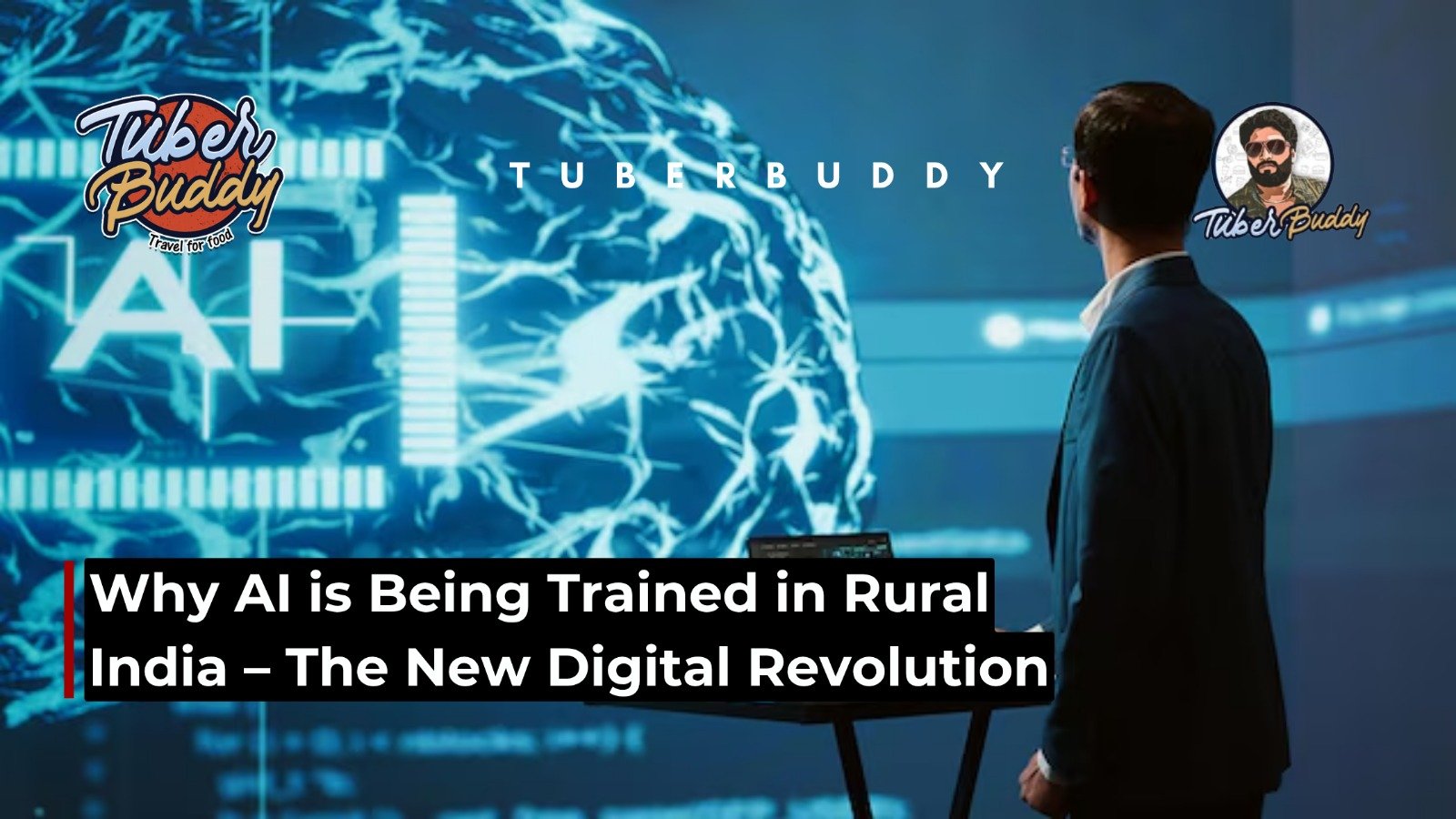Why AI is Being Trained in Rural India | The New Digital Revolution

Artificial Intelligence (AI) is transforming the world at a pace never before experienced. From medicine and education to business and agriculture, AI is changing the way humans live and work. But something truly remarkable is unfolding in India — AI is not merely being utilized in urban metropolises; it’s being trained in rural India.
This new wave is building a sustainable digital revolution in villages, empowering citizens and placing India at the world’s technological cutting edge. Let us see why this is taking place and what the future has in store.
1. The Emergence of AI and the Need for Data
AIs are trained by observing vast amounts of data. You require millions of images, voices, and examples of text to train an AI model. Suppose an AI tool needs to identify Indian accents or rural produce such as bullock carts, traditional crops, or village sceneries, then it requires data from the respective areas.
The majority of the world data used in AI consists of Western countries, and hence are not suitable for India’s diversity. That is where rural India enters. Villages offer a good source of local language, culture, and lifestyle data, and hence are perfect for developing inclusive and accurate AI systems.
2. Low-Cost and Skilled Labor Force
Another prime reason why AI is being trained in rural India is due to the presence of a large trainable workforce. Rural youth with suitable digital training and internet connectivity can easily undertake tasks of AI data labeling, voice recording, image tagging, and content moderation.
Some Indian startups and international technology companies are employing village and small city people to tag AI data. These don’t necessarily require high technical abilities — only computer literacy and the willingness to pay close attention to detail.
This has generated new sources of income for people who previously depended solely on small-scale work or agriculture.
3. Government initiatives and Digital India Mission
India’s Digital India Mission and Skill India have gone a long way in bridging the digital divide. Rural youth are being educated in basic computer packages, data entry, and even AI-related activities under Common Service Centres (CSCs) and rural skills ecosystems.
Initiatives such as NITI Aayog’s AI for All seek to bring AI literacy to all — even the most remote rural towns. This makes sure that the advantages of AI are shared equally, and not just confined to metro towns.
Investing in digital infrastructure — from better internet connectivity to training facilities — the government is bringing rural India into the worldwide technological revolution.
4. Affordable for Businesses
To businesses developing AI models, the cost matters most. Transporting individuals from urban areas or hiring from foreign firms would be costly. Yet when they hire and train rural professionals, they receive quality work at low costs.
Rural India presents a win-win scenario — businesses save money and rural people find new employment. Dozens of start-ups have already established “AI villages” where hundreds of rural workers who have been trained assist in training AI for voice recognition, image labeling, etc.
5. Language Diversity and Local AI Models
India boasts more than 22 official languages and thousands of dialects. To deploy AI in a practical manner for Indians, platforms must learn regional languages such as Tamil, Telugu, Bengali, Marathi, and others.
Rural areas assist in training such language models by providing voice samples, sentence translations, and verifying AI chatbots in regional languages. Apart from enhancing AI strengths, this brings technology within reach of those who do not possess English or Hindi literacy.
For instance, when a voice assistant can comprehend a farmer who is talking Kannada or Bhojpuri, this is the capability of AI trained with rural Indian data.
6. Village Women Empowerment
AI training modules are also empowering women in villages. Agencies are imparting digital literacy and work-from-home skills to women who now have the choice to work from home because of AI data-related work.
This shift is financially empowering women and allowing them to be their own economic contributors to their households without ever having to set foot in a city. Rural women communities are even starting local AI data initiatives — an elephant step toward technology gender equality.
7. AI for Rural Development and Agriculture
AI isn’t just being trained in rural India — it’s also being employed to enhance rural life. Farmers are employing AI-driven apps to predict weather, detect crop diseases, and increase yields. But so that these technologies can be applied, they require training data representative of rural agricultural patterns.
Which is why rural data gathering and AI model training go hand in hand. When AI products are trained using actual village data — weather patterns, crops, and soil quality — they give more and better answers to Indian farmers.
So, by assisting with training AI, rural India is in fact driving the technology that will later benefit them.
8. Creating Digital Confidence and New Career Opportunities
The majority of the rural youth had not dreamed of a technological future previously. However, as AI projects are now being initiated in villages, they are becoming digitally empowered and provided with new employment opportunities. They are becoming AI trainers for data, digital freelancers, and teleworkers for technology companies.
This has stemmed migration towards urban areas and boosted local economies. It also generates self-pride — the feeling that their work is making AI systems around the world learn and improve.
9. Rural Skills Investment by Tech Giants
Large corporations such as Google, Microsoft, and Amazon, and Indian start-ups, are also investing in rural AI programs. They collaborate with NGOs and local communities to construct digital training centers.
These centers educate teenagers on how to utilize digital technologies, label data, and learn AI concepts. All these partnerships are producing a new generation of technology-literate rural youth, able to work with the world’s most sophisticated technologies.
10. Challenges and the Road Ahead
Sure, there are certain obstacles. Internet access, no electricity, ignorance, and restricted access to electronic gadgets are some of the main obstacles in most villages. But with ongoing support from the government and private sector, the loopholes are gradually being sealed.
As AI becomes more central to India’s growth story, rural areas will play an even bigger role. The future will see AI hubs emerging from small towns, not just metro cities — bringing inclusive growth and equal opportunity to all.
Conclusion: Rural India – The Heart of AI’s Future
Rural India-trained AI is a tale of technology, yes, but also of hope, empowerment, and digital inclusivity. It illuminates the path whereby the potential of human intelligence, combined with artificial intelligence, can lead to authentic social change.
With rural communities integrated into AI training, India is not merely gearing itself towards a future dominated by technology but also towards guaranteeing that no one gets left behind.
The next time you talk to a voice assistant or an artificial intelligence program that is able to speak Indian languages, keep this in mind — somewhere in some village, someone assisted in training that system to listen, speak, and think like us.
For more stories that connect past and present, Follow Tuber buddy
